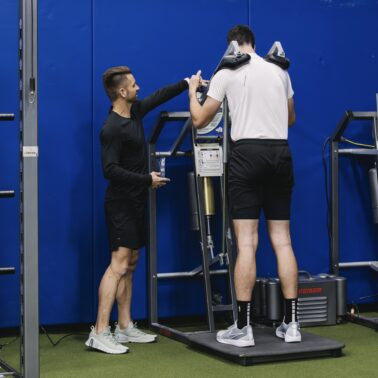“The problem with inflammation and swelling is not the presence of either. The problem lies in the body’s ability to fight gravity and clear the swelling. Ice helps with pain, but it reduces the ability to clear swelling.”
adam loiacono
What You Will Learn
- The physiology of using ice for an injury.
- The pros and cons of utilizing ice based on the desirable goal.
- How Adam incorporates ice into his rehab for athletes.
PRICE – protect, rest, ice, compression, and elevation. This is what my friends and family know what to do for an injury. RICE, or the updated version of PRICE, is what was taught to me in my undergraduate athletic training program days. It was then again emphasized during my Doctor of Physical Therapy program. There’s an ice machine in every athletic training room I have ever been in. Therefore, ice must be important, right?
Over the recent years I’ve changed my viewpoint on whether ice should be used or not. I’ll show you how I best use ice for a sports injury or during my rehabilitation for athletes. Before I discuss how I use ice, let’s better understand what it is exactly ice is doing.
Physiology of Using Ice
Pain
Pain is a whole topic in and of itself. In short summary, pain is a unique experience individualized to every human. No two humans have the same pain experience. Pain is dependent on three key factors – past experiences, current situation, and future implications. So how does ice affect pain?
One theory of pain is the Gate Control Theory. The Gate Control Theory is this idea that certain action potentials, “pain signals,” transmit or restrict signals based on other concurrent action potentials. Simply put – if you bang your elbow on the corner of a table and start rubbing your elbow, then the signals your nervous system receives from the act of rubbing and touching your elbow restrict the pain signals that came from banging your elbow. I’m sure we all have banged our elbow or head and as soon as we start rubbing it, our elbows and heads feel better. Even your mom & dad were right in telling you to “walk it off” – your joint receptors from walking were overriding the pain signals.
Ice is synonymous with rubbing our elbow and “walking it off.” Rubbing our elbow stimulates mechanoreceptors in our skin, walking stimulates joint receptors, and ice stimulates thermoreceptors – all of which inhibit the concurrent “pain signals” (the technical, modern term is nociceptive signals).
Applying ice to a sprained ankle or a knee contusion from knocking knees with an opponent can help restrict some of those pain signals and ultimately reduce pain.
Temperature
Applying ice to an injured area makes the skin cold to touch and stimulates those thermoreceptors to temporarily inhibit pain. Depending on how long ice bags, GameReady, cold plunges, or other forms of cryotherapy are used, other tissue temperature changes can occur too. Part of the intent of applying ice to reduce deeper tissue temperatures is to reduce nerve conduction velocity (the speed at which those pain signals travel to your brain) and reduce the local cell metabolism.
Why would the goal be to reduce local cell metabolism? The simple answer – to reduce the effects of the inflammatory response and subsequently reduce the magnitude of the injury. This perspective would imply that the inflammatory response is undesirable.
I question this perspective and I’ll pose this question from evoluiton as a reference point. If acute inflammation was undesirable following an injury, then why after tens of thousands of years have we not evolved to eradicate the acute inflammatory response?
(Please note that I am distinguishing acute inflammation from chronic inflammation. By no means am I suggesting that chronic inflammation is desirable. I am suggesting that we may need to reconsider if inflammation is desirable or not in an acute injury scenario. More on this later…)
Fluid Movement: lymphatics & Blood Flow
Lymphatics and veins are synonymous with our home’s outgoing plumbing system and our arteries our synonymous with our home’s incoming water supply from the city. Nutrients in via the arteries and wastes out via the veins and lymphatics. How does ice and a reduction in tissue temperature affect these tissues?
An overall reduction in tissue temperature is going to produce vasoconstriction to the arteries. Vasoconstriction is the reflexive action to reduce the blood flow by making the diameter of the vessel smaller. The original intent of vasoconstriction and ice was to reduce the incoming flow of blood to the injured site to indirectly reduce the amount of swelling.
Again, I will question this perspective and ask, “Do we want to impede the inflow of fluid to the local area?” The natural inflammatory response wants to send a mirage of white blood cells and chemical mediators to the injured site to initiate the healing response. Should we be blunting this acute response?
Next, how does tissue temperature impact the outflow of fluid through the lymphatic system? The first part of this answer is that ice can reverse the flow of undesirable swelling from the lymph system (technically speaking, the reduction in tissue temperature changes the permeability of the lymph vessels). The second part of this answer is colder fluid is more difficult to move (cold temperatures increase viscosity).
In summary, changes in tissue temperature negatively impact the ability to remove fluid from the injured site. Thinking back to our plumbing analogy, icing can clog your toilets and create a backflow that spills over onto your bathroom floor.
How Do I Use Ice for Sports Injuries?
Pain Management
Ice can reduce and even eliminate pain – temporarily. If the ice is being applied, then the stimulation of thermoreceptors can restrict the pain signals that your brain is receiving which subsequently reduces our perception of pain.
But is reducing pain a desirable outcome? Maybe. If our goal is to get comfortable so we can relax and recover, then yes – use ice to do this. But if our goal is to understand if we can progress rehab or training, then perhaps we need the perception of pain to guide us. We must consider that pain after an injury is very valuable information because it is our body’s caution signal. If pain exists, our body is communicating that whatever we are doing we may need to reconsider before progressing forward.
I will use ice early in rehab for pain management following an acute injury because pain can be very uncomfortable. I believe in managing the entire person (their entire human system) and not just the local injury. If icing is going to help reduce pain with the intent to allow an athlete to get comfortable and possibly take a nap or fall asleep, then yes, I am all for ice.
Swelling
I do my best to base my decisions on principles that are rooted in human physiology and am also a supporter of allowing the body’s natural responses to do the very thing they were designed for. Acute inflammation is necessary and beneficial for an injury. I much rather prefer not to blunt this response. Therefore, if my goal is to reduce swelling, then utilizing ice is not my preference.
The problem with inflammation and swelling is not the presence of either. The problem lies in the body’s ability to fight gravity and clear the swelling. Ice helps with pain, but it reduces the ability to clear swelling.
My number one goal in early rehab is to clear swelling as fast as possible.
We’ve learned that the cooling effects of ice reduce the ability to clear swelling. Clearing swelling is the keystone to early rehab. If swelling goes down then pain is reduced, range of motion & strength are improved, and ultimately function is restored quicker.



